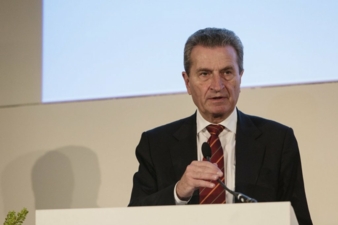24/02/2020 – Europe, the textile continent – opportunities and risks, Part 2 — auf Deutsch lesen
“Europe’s Green Deal Textile – making the impossible possible!”
For students studying fashion design at Hanover’s University of Applied Sciences and Arts, the 13 January is an exciting day. It’s Fashion Week in Berlin and they are part of it.
It’s Fashion Week in Berlin and almost 2,000 spectators are queuing inside the Reef Conference Centre. Berlin has never seen the like before: three fashion shows in quick succession, each an hour long, with throngs of people and plenty of hustle and bustle both backstage and front.
Trend scouts from the big European labels have arrived and The Confederation of the German Textile and Fashion Industry (textil+mode) has invited industry members to its New Year’s Reception at the venue of Neo.Fashion.2020. As the sun sets over the fashion capital of Berlin, bathing the sky in a warm red glow, CEO Uwe Mazura welcomes the guests to Loft14 and declares: “We can do the Green Deal for Textiles.”
In Brussels, Ursula von der Leyen has just revealed details of her Green Deal, which she sees as Europe’s “Man in the Moon Project”. Johannes Diebel, Head of the German textile research board Forschungskuratorium Textil, believes that Germany’s textile industry and research are well equipped to tackle the challenges posed by the Green Deal. Indeed, textiles can do so much to protect both resources and the environment and even “Man in the Moon Projects” are already familiar territory for German textile researchers.
Building on the moon – with moon fibres!
Thilo Becker and Alexander Lüking, two young fibre specialists at RWTH Aachen University, have developed a material for building on the moon. Using moon rock, which is available in huge quantities on the moon and has a high basalt content, they have found a way to spin high-strength threads, so-called moon fibres with specially designed equipment no bigger than a small fridge. Space experts are already interested in the moon-rock development, as every kilogramme of material shot to the moon costs a good EUR 10,000.
The new decade will also bring about far-reaching changes in the European textile and fashion industry. After all, Europe has set its sights on becoming climate-neutral by 2050.
Climate-neutral fashion production is possible!
Indeed, many of the students’ final collections, paraded on the catwalk in Berlin, have already embraced the question of climate-neutral fashion production. Claudia Bumb from the Hanover University of Applied Sciences and Arts, for example, has created a circular collection called “Under Water Overflow”, which uses ecological and upcycled materials from cellulose, silk, cotton and ocean plastic.
Her fellow student Annika Jasmer has turned her attention to developing compostable fashion and has researched vegetable dyeing, handwoven cloth and high-quality natural materials in Iceland. The collections on the catwalk at Neo.Fashion.2020 are pointing the way to a new decade of sustainability.
Dark mood on energy
The sense of excitement and anticipation quickly dissipates when the subject changes to Germany’s Climate Package and its impact on the country’s textiles industry. According to a current survey conducted by textil+mode on the fuel trade emissions act (Brennstoffemissionshandelsgesetz, or BEHG for short), which was recently passed by the German Federal Government, energy-intensive textile producers, such as finishers and manufacturers of non-wovens, expect to see their energy costs spiral by an average of 20 percent from next year.
CEO Uwe Mazura knows a whole host of medium-sized companies who are even contemplating throwing in the towel: “It beggars belief that our companies not only have to contend with the highest electricity prices in the world but are also expected to foot the bill for the lacking availability of green energy for our production processes.” In his view, it is time to create some comparability in the climate ambitions of the major industrial nations. “Our companies achieve more than 40 percent of their sales through exports. They do so with products that are manufactured here in Germany using much more environmentally friendly and resource-efficient methods than elsewhere. What’s the gain for the climate if it simply becomes too expensive for us to produce here in Germany and the products are then manufactured abroad using very different methods?”
Wake-up call for politics
Industries across Europe are currently grappling with this question, albeit with very different portents. Speaking at the textil+mode conference, former EU Commissioner Günther Oettinger sends out a warning that Europe would first lose its industry and then its prosperity. “Industry doesn’t show its passport when it leaves a country. It makes a quiet exit, switching investments from Dortmund or Stuttgart to somewhere outside Europe. As each day goes by, we are losing our industrial base without even realising it,” concludes Oettinger.
While Brussels is wrestling over its EUR 1,000bn investment programme for the Green Deal, Germany’s medium-sized textile companies are wrangling for more realistic energy prices before 2021, when Europe’s biggest economy is scheduled to introduce CO2 pricing.
Michael Engelhardt, head of the energy division at textil+mode:
“A new energy policy can only succeed if, from day one, affected SMEs receive similar breaks within the CO2 pricing policy to the companies in the EU’s emissions trading system. Anything less would be an attack on our ability to compete. We’re wholly committed to the German government’s climate goals. However, we’re only just starting out on our journey to climate-neutral production. Our SMEs need a certain degree of wriggle room to be able to invest in and shape the Green Deal properly. But they’ll be robbed of any such freedom as soon as they’re exposed to the world’s highest electricity prices and the CO2 pricing model which is to be introduced next year. Many SMEs are seriously thinking about moving their production operations abroad.”
A poor signal for new talent
This would send out a negative message to students wanting to study fashion design or apparel technology at the HTW Berlin, for example. After all, they rely on having industry nearby. Working in collaboration with Hussein Challayan, the well-known British fashion designer with a Turkish-Cypriot background, Berlin is setting up a TextileHub with a focus on sustainability and innovation. “I decided early on that the only way you can do something new is by using technology. Engineers and programmers are creating things that have never existed before. For me, it’s all about innovation and taking risks. In fact, it’s about making the impossible possible,” states Challayan, introducing himself in Berlin. He is clearly on the same wavelength as Ingeborg Neumann, President of textil+mode, who at the start of Neo.Fashion.2020 speaks of a sea change that can only be managed if we all work together.





